-
 Korea.net's 24-hour YouTube channel
Korea.net's 24-hour YouTube channel- NEWS FOCUS
- ABOUT KOREA
- EVENTS
- RESOURCES
- GOVERNMENT
- ABOUT US
Back in the late 15th century, Columbus' landing on a new continent had a huge effect on cuisine and dietary styles across the globe. One of the influences was chocolate. Its arrival in Korea is presumed to be around the end of the 19th century.
As one story has it, Empress Myeongseong (1851-1895) was given chocolate as a present from foreign missionaries at the end of 19th century. However, it was introduced to the public only in the 1950s when the U.S. military was stationed in the country. Chocolate spread across the whole peninsula and people began to recognize its unique smell and sweet taste. Finally, in the 1970s, with most domestic confectionary companies equipped with chocolate production facilities, chocolate took root in this land.
Today, it is widespread, even in small super markets. Only a decade ago, it was rare to be able to taste a little piece of chocolate. Since then, however, times have changed. There are now a growing number of cafés that serve hand-made chocolate adorned with creative designs.
One of the better known hand-made chocolate cafés is Folabi, located in Ichon-dong, Yongsang-gu, in central Seoul. Folabi's chocolatier, Hong Kyoung-chun, treats the chocolate as if it is a piece of art.
Korea.net met with him at his café where he was devoting all his energy to designing and producing chocolate and, with it, to communicating with customers about the beauty of the cocoa bean.
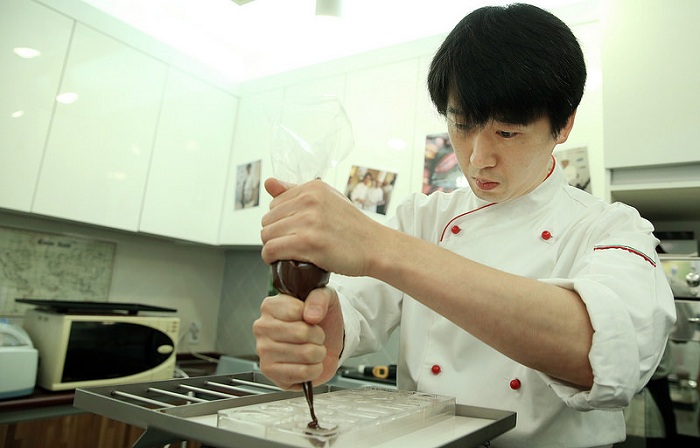
Opened in September 2011, Folabi has 12 types of hand-made chocolate, as well as a range made with a special theme, such as flowers, shoes or pianos. Folabi is a tiny café with only two tables squeezed along the side, but it's lovely. It is clear how much Hong loves, cares and creates the space for his creations.
"Everyone seems to fall in love with chocolate when they're young, don't they?" replied Hong, when asked about how he became attracted to it. He added that he had always enjoyed cooking, even before he opened his shop. Realizing that he was passionate about cooking, he quit his previous job at an automobile-related company and headed for Italy in 2008.
"Without the support of my wife, it would have been completely impossible," said Hong. Back then, hand-made chocolate was quite rare, but the couple believed in its possibility. Producing chocolate was not simply a means to make a living, but was what made him passionate and a happy person.
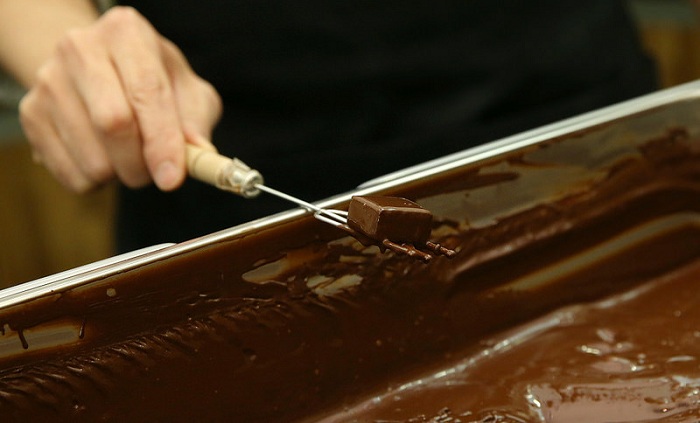
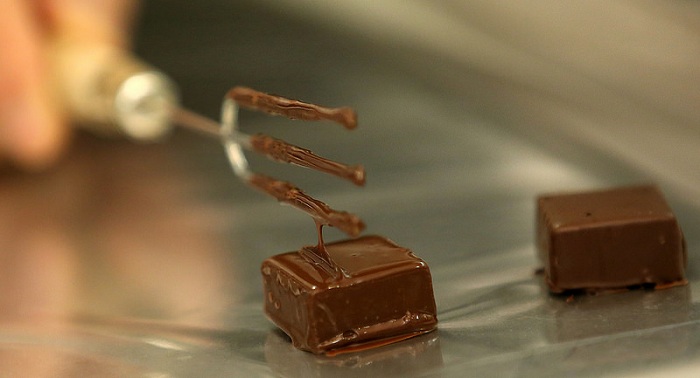
He stayed in Italy for about three years, visiting various regions -- including Bologna, Venice, Milan and Rome -- where he completed a number of courses in chocolate production, chocolate design and gelato production. He also worked at a small family-run chocolate factory in Ferrara. "My experience in Europe helped open my eyes to the refined and sophisticated designs, as well as to deliciousness," he said.
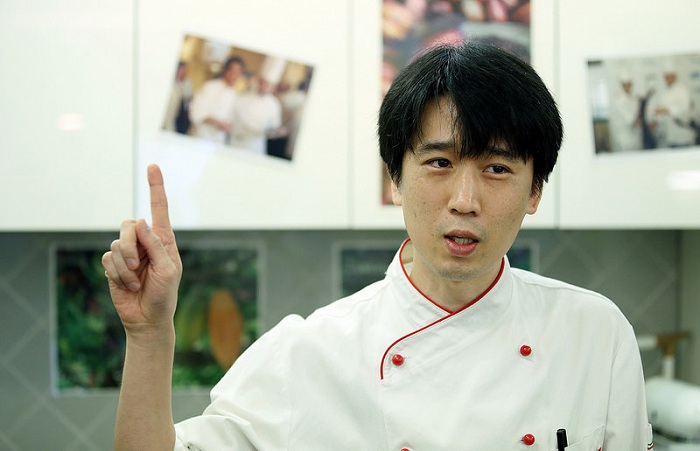
"The most important step is 'tempering.' That warms up the chocolate to an appropriate degree of temperature," Hong explained. "First, cacao chocolate should be melted to around 50 or 60 degrees Celsius. Then it should be cooled to a certain, appropriate temperature, differing depending on whether it is milk or dark, to produce a new form of chocolate."
To bring it to a favorable temperature, he sometime has to put icy plates under the chocolate batter, and sometimes warms it up again. "The tempering process should be done perfectly in order to make the chocolate look nice and taste nice."
Chocolate set at a favorable temperature should then be evenly spread into the mold, allowing for various shapes. During this process, Hong puts the chocolate mold onto a vibrating machine so that the chocolate can fill the mold with no air bubbles.
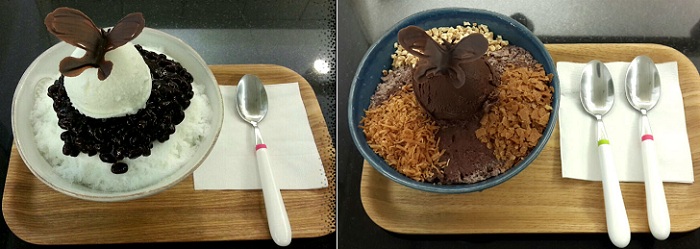
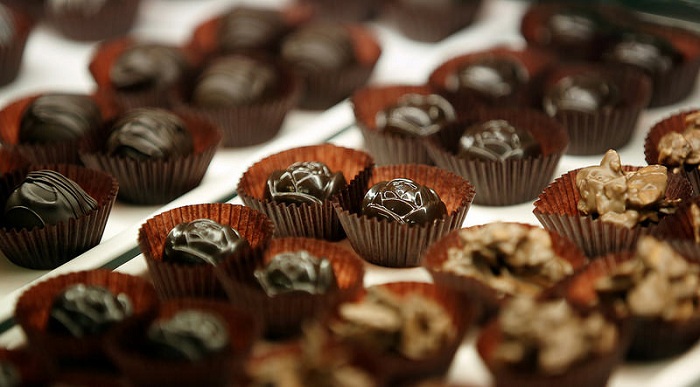
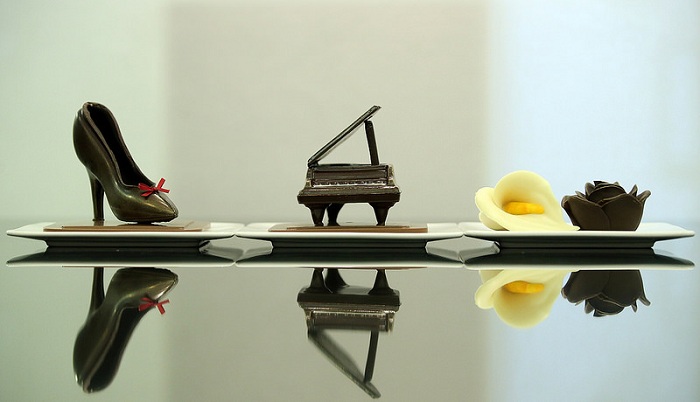
Korea.net was given the chance to taste balsamic hand-made chocolate, which contains a bit of vinegar. Unlike processed chocolate sold in most supermarkets, it exuded a stronger aroma of cacao. Also, it had less sugar, so it was okay to eat a number of pieces. The sweet, yet slightly bitter, taste left a wonderful lingering flavor in the mouth.
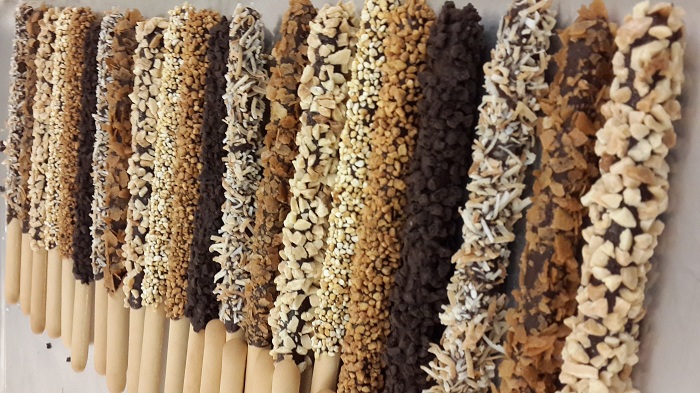
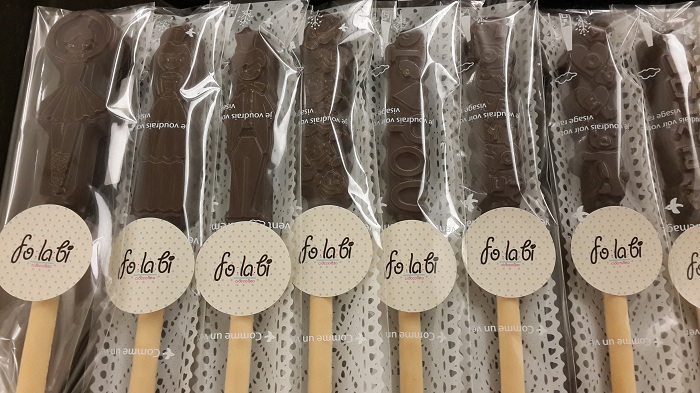
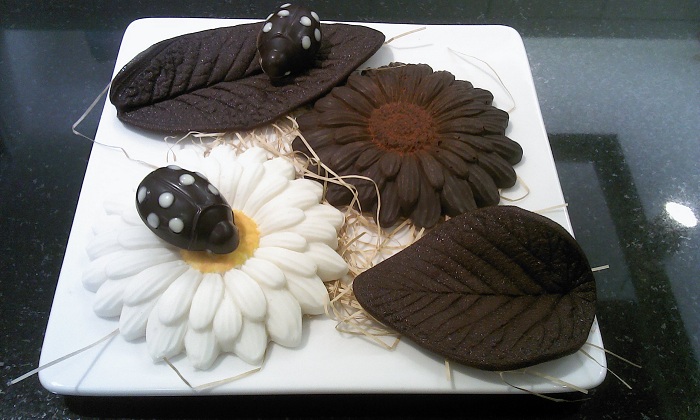
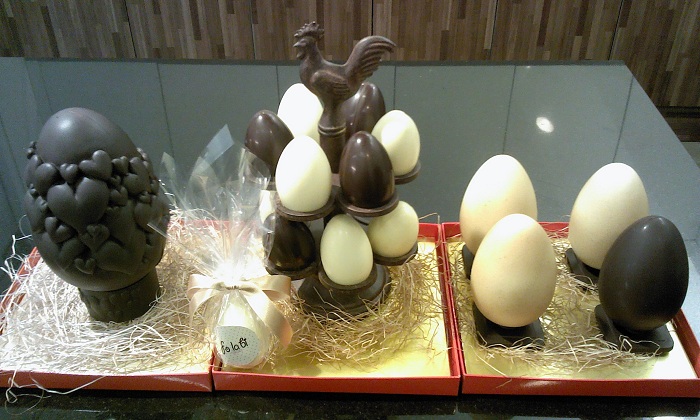
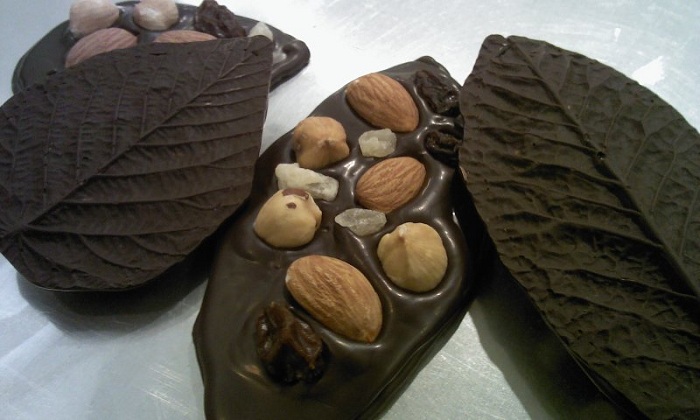
Beautifully decorated chocolate sits in the glass showcase, waiting for buyers. When Folabi first opened, very few people bought high-end chocolate. Most people came in, looked around with a curious eye and then left. Today, however, the café has a variety of patrons. During the daytime, the café is mostly visited by young women in their 30s and 40s, and those who want to buy a small yet meaningful present. Male customers visit during the evening to buy a present for the family. It is also frequented by a higher-than-usual number of non-Korean patrons, as Ichon-dong is one of the Seoul neighborhoods that are home to a higher-than-usual number of non-Korean residents, particularly from Japan and the U.S. Recently, one of his Japanese customers ordered a big box of chocolate for her friends and family because she was planning to go back home to visit.
Since Hong opened Folabi, he has hardly enjoyed any weekend or holiday. Sometimes, he spends more than 14 hours a day at the café. However, he says he is happy that he can produce chocolate for those who recognize the value of "real cacao" and for those who have fallen in love with Folabi.
"I will dig deeper to learn more about chocolate and new designs. One day, I hope I can submit an entry at the Salon Du Chocolat," said Hong, referring to the yearly trade fair for the international chocolate industry.
*Folabi Homepage: http://blog.naver.com/folabi
By Lee Seung-ah
All photos: Jeon Han
slee27@korea.kr
As one story has it, Empress Myeongseong (1851-1895) was given chocolate as a present from foreign missionaries at the end of 19th century. However, it was introduced to the public only in the 1950s when the U.S. military was stationed in the country. Chocolate spread across the whole peninsula and people began to recognize its unique smell and sweet taste. Finally, in the 1970s, with most domestic confectionary companies equipped with chocolate production facilities, chocolate took root in this land.
Today, it is widespread, even in small super markets. Only a decade ago, it was rare to be able to taste a little piece of chocolate. Since then, however, times have changed. There are now a growing number of cafés that serve hand-made chocolate adorned with creative designs.
One of the better known hand-made chocolate cafés is Folabi, located in Ichon-dong, Yongsang-gu, in central Seoul. Folabi's chocolatier, Hong Kyoung-chun, treats the chocolate as if it is a piece of art.
Korea.net met with him at his café where he was devoting all his energy to designing and producing chocolate and, with it, to communicating with customers about the beauty of the cocoa bean.

Chocolatier Hong Kyoung-chun fills an empty mold with chocolate.
Opened in September 2011, Folabi has 12 types of hand-made chocolate, as well as a range made with a special theme, such as flowers, shoes or pianos. Folabi is a tiny café with only two tables squeezed along the side, but it's lovely. It is clear how much Hong loves, cares and creates the space for his creations.
"Everyone seems to fall in love with chocolate when they're young, don't they?" replied Hong, when asked about how he became attracted to it. He added that he had always enjoyed cooking, even before he opened his shop. Realizing that he was passionate about cooking, he quit his previous job at an automobile-related company and headed for Italy in 2008.
"Without the support of my wife, it would have been completely impossible," said Hong. Back then, hand-made chocolate was quite rare, but the couple believed in its possibility. Producing chocolate was not simply a means to make a living, but was what made him passionate and a happy person.


Chocolatier Hong Kyoung-chun shows how to do a 'dipping' of the chocolate, one of the main chocolate-producing processes.
He stayed in Italy for about three years, visiting various regions -- including Bologna, Venice, Milan and Rome -- where he completed a number of courses in chocolate production, chocolate design and gelato production. He also worked at a small family-run chocolate factory in Ferrara. "My experience in Europe helped open my eyes to the refined and sophisticated designs, as well as to deliciousness," he said.

Chocolatier Hong Kyoung-chun explains the importance of the 'tempering' process, a necessary step to produce chocolate.
"The most important step is 'tempering.' That warms up the chocolate to an appropriate degree of temperature," Hong explained. "First, cacao chocolate should be melted to around 50 or 60 degrees Celsius. Then it should be cooled to a certain, appropriate temperature, differing depending on whether it is milk or dark, to produce a new form of chocolate."
To bring it to a favorable temperature, he sometime has to put icy plates under the chocolate batter, and sometimes warms it up again. "The tempering process should be done perfectly in order to make the chocolate look nice and taste nice."
Chocolate set at a favorable temperature should then be evenly spread into the mold, allowing for various shapes. During this process, Hong puts the chocolate mold onto a vibrating machine so that the chocolate can fill the mold with no air bubbles.

Butterfly Bingsu is one of the summer special menu items at Folabi. With a chocolate butterfly adorning the top of the bingsu, it is delicious to both look at and to eat.


A variety of hand-made chocolates are on sale at Folabi.
Korea.net was given the chance to taste balsamic hand-made chocolate, which contains a bit of vinegar. Unlike processed chocolate sold in most supermarkets, it exuded a stronger aroma of cacao. Also, it had less sugar, so it was okay to eat a number of pieces. The sweet, yet slightly bitter, taste left a wonderful lingering flavor in the mouth.


Stick chocolate is on sale at Folabi in celebration of Paepaero Day, November 11.



Hong's hand-made chocolates suggest that he always studies new designs and looks for new things.
Beautifully decorated chocolate sits in the glass showcase, waiting for buyers. When Folabi first opened, very few people bought high-end chocolate. Most people came in, looked around with a curious eye and then left. Today, however, the café has a variety of patrons. During the daytime, the café is mostly visited by young women in their 30s and 40s, and those who want to buy a small yet meaningful present. Male customers visit during the evening to buy a present for the family. It is also frequented by a higher-than-usual number of non-Korean patrons, as Ichon-dong is one of the Seoul neighborhoods that are home to a higher-than-usual number of non-Korean residents, particularly from Japan and the U.S. Recently, one of his Japanese customers ordered a big box of chocolate for her friends and family because she was planning to go back home to visit.
Since Hong opened Folabi, he has hardly enjoyed any weekend or holiday. Sometimes, he spends more than 14 hours a day at the café. However, he says he is happy that he can produce chocolate for those who recognize the value of "real cacao" and for those who have fallen in love with Folabi.
"I will dig deeper to learn more about chocolate and new designs. One day, I hope I can submit an entry at the Salon Du Chocolat," said Hong, referring to the yearly trade fair for the international chocolate industry.
*Folabi Homepage: http://blog.naver.com/folabi
By Lee Seung-ah
All photos: Jeon Han
slee27@korea.kr
Most popular
- First hearing-impaired K-pop act hopes for 'barrier-free world'
- Expats could account for 7% of population in 20 years: report
- 'Mad Max' director impressed by 'cinema-literate' Korean viewers
- Show in Italy to present 'thought-filled' Korean craftworks
- Romanian presidential couple visits national cemetery













